
WDFW Commission Hears NE WA Ungulate, Predator Concerns
Updated 9:26 a.m., Saturday, October 29, 2022 with new 22nd and 23 paragraphs.
Northeast Washington hunters, ranchers, local residents and elected officials talked to the Fish and Wildlife Commission today about rising predator numbers and declining ungulate numbers.
Speaker after speaker this morning said they’re seeing fewer and fewer deer but also longterm increases of wolves, cougars and black bears, making for much tougher hunting, increased domestic animal depredations and safety concerns.

They want the citizen panel that oversees WDFW to better manage the wild herds and carnivores and used the commission’s trip this week to Colville to make their thoughts known. The meeting was broadcast over TVW and on Zoom.
It was a message “from the center of wolf recovery,” as one state representative put it and whose comment led off local media coverage.
State wildlife managers have their population data, of course, but in addition to numerous anecdotes, today’s commenters offered some “citizen science” observations of their own.
Freddie Giannecchini said that in years gone by, he would see 2 deer a mile and 14 bucks a day on his 45-mile roundtrip to work as a longtime employee of Clarks All Sports in Colville, but this year he’s averaged one deer per every 46 miles and just nine bucks overall.
He acknowledged last year’s horrible EHD and bluetongue outbreaks among local whitetails, but also that deer harvest after 2015’s dieoff was still around 8,000 animals and it’s dropped off by 60 percent.
Last year’s general seasons saw 3,544 taken, a low mark over at least the past nine falls if not much further back. The 2015 hunt was very good statewide and in the northeast it was buoyed by relaxation of the four-point minimum.
“If we have another year with bluetongue or a hard winter, we’re going to be out of deer” and then what with predators?, Giannecchini wondered.
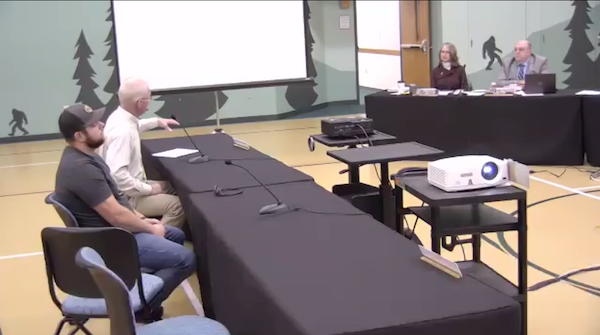
Steve Bruchman who lives on 5 acres in the Kettle Falls area, said he’s seen a steady decline in deer numbers the past decade or so as well as increasing predator tracks left in the snow. He related a story about how his grandchildren had built a snowman and afterwards he found large wolf tracks intermixed with those left by the kids.
“We live in fear,” he said.
Hunter Bill Philpot noted that years back logging on private land had opened up habitat for ungulates but that bounty has dissipated. As a shed antler hunter he said he just isn’t seeing the amount of skeletons in the woods he used to.
“It’s just all going downhill,” he said.
Jim Ebel, who said he’d lived in the area from a young age, said he hadn’t seen so few deer “since the winter of ’68,” his first year hunting. He said hunters used to have WDFW and the commission’s back, but not so much more, pointing to the cancellation of the spring bear hunt and outlawing of coyote derbies.
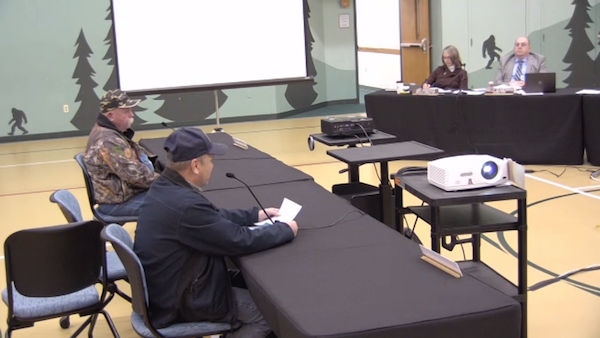
Rancher Scott Nielsen, who was among several livestock producers who spoke to trust issues with WDFW around wolf management and called for more coordination with local governments, said that as a young men, there were times when he could count 400 or more deer on one particularly rich south-facing slope that greened up early in spring, but the last several years he hadn’t counted more than 30.
“I’m not a scientist but I think we have a predator-prey imbalance,” he said.
For its part, WDFW openly acknowledges carnivores do have impacts on ungulates.
“And combined with all the other factors, it can add up to a drop in population numbers in some years, depending on what else is happening,” spokeswoman Staci Lehman in Spokane told me early last month.
Some of “the other factors” she points to include the aforementioned disease issues, plus wildfire, drought and roadkill – “people don’t realize just how many deer are hit by cars.”
And then there’s habitat loss; this landscape just is not what it was in the 1980s for whitetails as old farms and forests are converted to development.
To rebuild the whitetail herd, WDFW has sharply curtailed antlerless permits in recent years. But meanwhile the region is brimming with wolves, locked into population-based cougar harvest quotas and the spring bear hunt has infamously been taken away by a faction on the commission. The bruin season was in part to mitigate losses on the fawning and calving grounds.
On Saturday’s session of the commission, as he gave a “director’s report” for Region 1, WDFW’s Steve Pozzanghera noted that cougar issues have actually been declining in recent years in far Eastern Washington, from 312 and 311 calls for service in 2020 and 2021 to 166 this year through October 1, “a substantive decline,” and 70 and 69 removals in 2019 and 2020 to 27 in 2021 and 10 in 2022 through the start of this month, “a significant decline in the number of cats removed.”
Asked what he thought was contributing to the decline, Pozzanghera suggested it was a combination of removing cougars that have a “propensity” to cause livestock depredations or safety issues and outreach and education efforts about living in lion country.
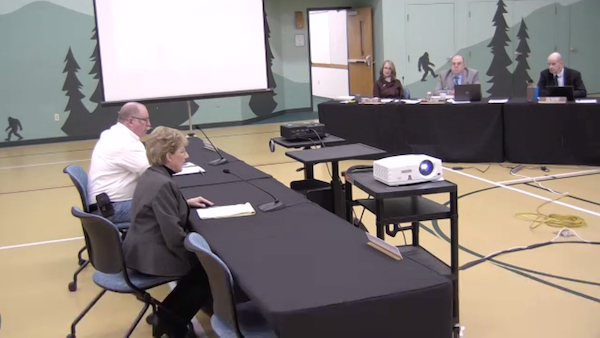
Two state lawmakers and at least three county commissioners were also on hand to provide their input to members. Sen. Shelly Short (R-District 7) brought up a midsummer Spokane Spokesman-Review article on the joint WDFW-UW Predator-Prey Project in which a researcher said Northeast Washington whitetail populations were “stable,” though that data point was from before 2021’s disease dieoff and was pushed back on by WDFW.
More findings from the project are expected to be revealed at the upcoming The Wildlife Society meeting conference in Spokane and in researchers’ dissertations, as well as at the commission’s Dec. 8-10 meeting in Clarkston.
Wes McCart, a Stevens County Commission member, said that there are more wolves and packs in his and neighboring Pend Oreille and Ferry Counties than all of Alaska’s Denali National Park, foresters are telling him about “record” numbers of trees being destroyed by bears, and he spoke to this year’s attack by a cougar on a 9-year-old girl at a church camp.
“Folks, our numbers are way too high,” McCart said.
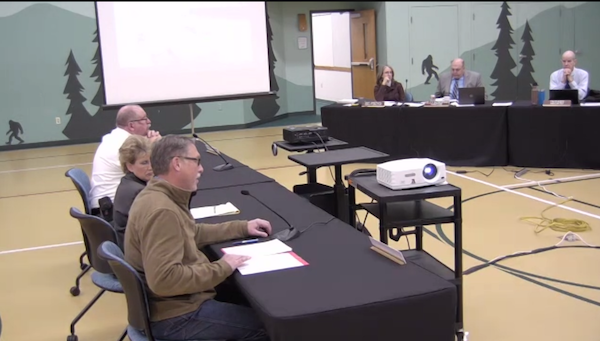
Fellow commissioner Mark Burrows said his wife doesn’t feel safe going for a horse ride in the woods and she doesn’t want to take their dogs with her for safety.
“I’m here to tell you I’m seeing more cougar, wolf and bear tracks,” he said.
Rep. Joel Kretz (R-D7) called wolf recovery “successful. We’ve done our part and need to move onto a new phase.” He said the ranching community had come around from where it was 10 to 15 years ago on wolves and was using nonlethal preventative measures, but he still wanted to see more openness from WDFW on local involvement.
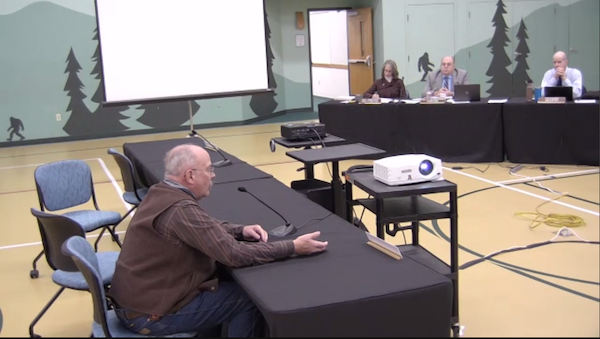
That was echoed by rancher Ted Wishon, who said he was happy with WDFW Director Kelly Susewind and the agency’s help with nonlethal measures and legislative grants on that front, that he was the last person who wanted a wolf killed on his land, and that he was looking for ways to “bridge this grand canyon” in an environmentally sensitive way.
Asked how by Fish and Wildlife Commission member Kim Thorburn how, Wishon said to enlist county commissioners and sheriff’s offices. Stevens County has its own large animal conflict specialist in the form of Deputy Jeff Flood.
The few wolf advocates in attendance in Colville were notably muted, speaking to beavers or offering insights on where they were seeing deer during a strangely warm, dry fall that saw some but not all hunters having difficulties locating bucks.
Samantha Bruegger of Washington Wildlife First and a member of the new “Washington Fish & Wildlife Management Reform Convention Steering Committee,” spoke about what she and her family had in common with locals, stating that they owned 115 acres, had horses and a blue heeler, and wolves, bears and cougars had been seen on their land, with kids and cats coming briefly into contact “without harm.”
“We want to live with the carnivores on our landscape,” Bruegger said.
The commission’s trip to Colville offered a reunion of sorts. Former Vice Chair Gary Douvia said there weren’t enough fawns around anymore to rebuild the whitetail herd and he summarized that people were asking those who sat on the panel now to do a better job in terms of safety and predator and prey populations.
Douvia, who served from early 2007 into mid-2013 and spoke to certain elements of the development of 2011’s statewide wolf management plan, said folks didn’t mind predators on the landscape as long as there is a balance.
“You’ve got people on the commission who are 1,000 percent predator pro, but that will only hurt predators when they are overpopulated,” he said.
Pointing to the formation of the board by voters, Douvia said it was created to get politics out of fish and wildlife management, “not for a popular vote.”

Several WDFW commissioners thanked today’s speakers, with Jim Anderson of rural Pierce County saying he’d “learned a lot.”
Commissioner Lorna Smith of Port Townsend was more standoffish: “We heard you; however, we represent the entire state. We have very different perspectives and we represent those people as well.”
She said that with hunter numbers declining, which impacts license revenues that go directly to WDFW, and increased General Fund support from the legislature in recent years, there was “an obligation to be more responsive to all people.”
Commissioner Don McIsaac of rural Clark County, noting that “Darwin started writing things down in books about birds,” a reference to the day’s citizen science offerings, asked Director Susewind to respond to concerns about wildlife populations and the idea WDFW isn’t managing predators, and he said he wanted to keep the conversation going.
Correction, 9:26 a.m., Monday, October 31, 2022: The last name of Jim Ebel was misspelled in the initial version of this blog. Our apologies.
